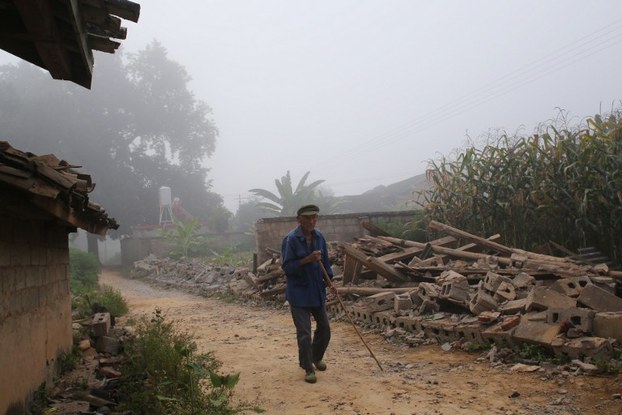




Thousands of victims of a powerful earthquake in the southwestern Chinese province of Yunnan were left with no shelter on Wednesday after the previous night's tremor left one person dead and caused cracks in a nearby dam, official media reported.
Rescuers are still searching for survivors in Yunnan's Jinggu county, as frequent aftershocks hit the region following the main quake with a magnitude of 6.6 late on Tuesday.
Some 124,000 people have been made homeless by the quake, while local officials said some 100 schools were damaged, official media said. More than 320 injuries have been reported so far.
However, rescue workers have been able to access the worst-hit region around Jinggu's Yongping township with relative ease, as there has been little rain in recent weeks, Xinhua news agency reported.
A resident of nearby Pu'er city surnamed Xie said the quake hit just before 10.00 p.m. Beijing time on Tuesday night.
"It was pretty bad yesterday evening," Xie said. "The tremors were very big and could be clearly felt on the ground floor."
"We are about 100 kilometers [62 miles] from Jinggu county," he said.
A village official in Jinggu county said many single-story buildings had collapsed in the quake, leaving people huddled outside with no shelter.
"There has been nothing [in the way of relief supplies] so far," the official said. "The thing we really need most are tents, because everyone's houses have been damaged."
"We can't stay in them, so we are living out here under the open sky," he said. "It's very difficult without tents."
Aftershocks continue
A resident of Jinggu county said aftershocks are continuing to hit the region.
"There are aftershocks; the biggest I think was about 5 [on the Richter scale]," he said.
Meanwhile, Yunnan governor Li Jiheng has called on water resources officials to "emergency measures" to safeguard a dam at Changhai Reservoir, some 10 kilometers (6 miles) upstream of Yongping, amid fears it may have been cracked in the temblor, Xinhua reported.
A crack measuring 5-8 centimeters (2-3 inches) across appeared on the 180-meter (590-foot) dam after the earthquake, the 163.com news site reported.
Photos of the scene showed People's Armed Police officers standing around, pointing at a crack in the ground atop a major dam.
Some 100 people and three earth-moving vehicles were drafted on Wednesday to shore up the dam "and to protect the lives, the safety and the property of people living downstream," the report said.
Links to dams, reservoirs
The Jinggu quake comes just a few weeks after a powerful earthquake left nearly 600 people dead in Yunnan's Ludian county.
That quake occurred a few months after local authorities filled up a brand new 23 million cubic-meter (812 million cubic-foot) capacity reservoir nearby.
Chinese experts have repeatedly suggested that earthquakes in its mountainous southwestern regions can be linked to the large number of dams and reservoirs in the area.
Environmental activist Wu Lihong said major dams have an impact on stability, causing shifts at a tectonic level.
"The construction of major dams also results in the disappearance of a lot of species, because they lose their habitats," Wu said.
"They can also result in major disasters for humanity, for animals and plant life."
He said China's ecosystems have paid a "tragic price" for the massive Three Gorges hydroelectric project damming China's longest river, the Yangtze.
Reservoir-triggered seismicity is the term used by experts to describe the triggering of earthquakes by the physical processes that accompany the filling of large reservoirs.
The independent U.S. Commission on Large Dams has recommended that the link between dams and quakes should be considered for reservoirs deeper than 80-100 meters (262-328 feet).
Reported by Yang Fan for RFA's Mandarin Service. Translated and written in English by Luisetta Mudie.